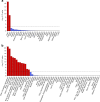Genome-wide association analyses of chronotype in 697,828 individuals provides insights into circadian rhythms
- PMID: 30696823
- PMCID: PMC6351539
- DOI: 10.1038/s41467-018-08259-7
Genome-wide association analyses of chronotype in 697,828 individuals provides insights into circadian rhythms
Abstract
Being a morning person is a behavioural indicator of a person's underlying circadian rhythm. Using genome-wide data from 697,828 UK Biobank and 23andMe participants we increase the number of genetic loci associated with being a morning person from 24 to 351. Using data from 85,760 individuals with activity-monitor derived measures of sleep timing we find that the chronotype loci associate with sleep timing: the mean sleep timing of the 5% of individuals carrying the most morningness alleles is 25 min earlier than the 5% carrying the fewest. The loci are enriched for genes involved in circadian regulation, cAMP, glutamate and insulin signalling pathways, and those expressed in the retina, hindbrain, hypothalamus, and pituitary. Using Mendelian Randomisation, we show that being a morning person is causally associated with better mental health but does not affect BMI or risk of Type 2 diabetes. This study offers insights into circadian biology and its links to disease in humans.
Conflict of interest statement
D.A.L. receives support from Roche Diagnostics and Medtronic for research that is unrelated to this study. M.K.R. reports receiving honoraria and consulting fees from Novo Nordisk, Ascensia, Cell Catapult and Roche Diabetes Care. K.V.A. received support from SANOFI-Aventis for research that is unrelated to this study. D.A.H. and 2.R.T. are employees of, and hold stock or stock options in, 23andMe Inc. The remaining authors declare no competing interests.
Figures






References
-
- Horne JA, Ostberg O. A self-assessment questionnaire to determine morningness–eveningness in human circadian rhythms. Int. J. Chronobiol. 1976;4:97–110. - PubMed
Publication types
MeSH terms
Substances
Grants and funding
- MR/P023576/2/MRC_/Medical Research Council/United Kingdom
- MC_UU_00011/3/MRC_/Medical Research Council/United Kingdom
- MC_UU_00011/2/MRC_/Medical Research Council/United Kingdom
- MC_QA137853/MRC_/Medical Research Council/United Kingdom
- MR/P012167/1/MRC_/Medical Research Council/United Kingdom
- T32 HL007901/HL/NHLBI NIH HHS/United States
- 107851/Z/15/Z/WT_/Wellcome Trust/United Kingdom
- F32 DK102323/DK/NIDDK NIH HHS/United States
- MC_PC_17228/MRC_/Medical Research Council/United Kingdom
- MC_UU_12013/5/MRC_/Medical Research Council/United Kingdom
- R01 DK105072/DK/NIDDK NIH HHS/United States
- MR/M005070/1/MRC_/Medical Research Council/United Kingdom
- K01 HL136884/HL/NHLBI NIH HHS/United States
- R01 DK107859/DK/NIDDK NIH HHS/United States
- R01 DK102696/DK/NIDDK NIH HHS/United States
- MC_UU_00011/6/MRC_/Medical Research Council/United Kingdom
LinkOut - more resources
Full Text Sources
Other Literature Sources

